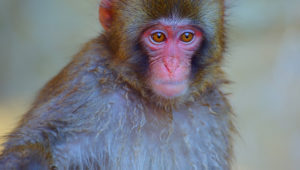By Freddy Moyano
Correspondent
BROWN COUNTY – Our September visit to the Northeastern Wisconsin (NEW) Zoo & Adventure Park in Suamico was guided by Senior Zookeeper, Jessica Hutjens, who introduced us to a group of seven Japanese snow macaques, also known as snow monkeys.
“They are more of a cold weather primate — the most northern-living primates in the world. That’s the dominant male, Arashi, who has come out to tell me I’m not allowed to look at anybody,” Hutjens said, pointing to the largest of the group who seemed especially alerted by our presence.

Hutjens said the two males and five females of the group have access to a den that is adjacent to the exhibit.
It is heated in the winter and partially air-conditioned during the summer.
“They like to play with the water feature,” Hutjens said. “They are known for their love of hot springs in Japan during the cold winters. Tatsu is our water baby. They all have Japanese names. She especially enjoys playing with the water feature, like all the young ones we’ve had before.”
Chubby cheeks
Hutjens said the monkeys are omnivores and their diet consists mostly of fruits and vegetables.
She said Tatsu was only nursed for about two weeks before she started eating solids on her own.
Hutjens said they also feed them a monkey chow specially formulated for primates with the nutrients they need.
The cheek pouches they have on each side of their face work, Hutjens said, as food storage.
“They will gather food in groups and store it in their pouches. Then they will separate themselves and start eating it. Even soon after they are born they will stuff edibles inside and take them out of their mouths to see if they’d like it to eat or not,” Hutjens said.
Genetically paired
Hutjens said births do not happen every breeding season, which runs from the end of December to March.
“I have seen most of them born here, except for the oldest two females, who were Tatsu’s age when I started,” Hutjens said.

She said a key element in the success of breeding program is the organizational support and information the Zoo receives from the Species Survival Program (SSP) which most zoos are part of.
“All the members of the Association of Zoos & Aquariums in North America will collaborate together with the SSP and transfer animals between institutions. There is an SSP coordinator for each set of animals, including one for the macaques, who looks at genetic values to determine who the best match is to pair a macaque with. They also issue recommendations on habitat placement” said Hutjens.
As for their lifespan, she said they’ve had some females live up to 35 years old, although the average listed on the information sign on the exhibit is 30 years.
Hiecharchy and COVID
Hutjens said macaques are very social animals that organize themselves in hierarchies.
They perform grooming and other tasks to keep each other clean and in harmony with the group.
Hutjens said their hierarchy consists of a dominant male and a female with everybody else falling right below.
“We have not had any major problems,” Hutjens said of the troop. “In other cases, the primates had to be separated to avoid issues, but luckily we have not had that problem here.”
Hutjens said whenever they clean the dens, Zoo staff goes in covered with suits and masks to protect themselves and the primates.
“In April we got COVID-19 vaccines for all of our big cats and macaques. They got their first shots, and two weeks later everyone got their boosters” said Hutjens.
She said no side effects were visible on any of the seven inhabitants.
Enrichment
“Macaques are very intelligent, so they get enrichment every day, consisting of different categories that we rotate. Some of those enrichment activities are meant to elicit natural behaviors such as foraging” said Hutjens. “On the cognitive side, we will put seeds or nuts in puzzle feeders so they figure out how to get them out. It challenges their mind, keeping them healthy and active” Hutjens said.
How to help
Stay tuned for next month’s resident animal and special NEW Zoo events and upcoming attractions.
For information on how to get involved and help the NEW Zoo, visit newzoo.org/get-involved where you will find details on volunteering, job shadowing, etc.
Freddy Moyano is a wildlife expert and award-winning videographer based in Green Bay. For more about Freddy’s award-winning wildlife videos, visit instagram.com/freddymoyanoofficial.
